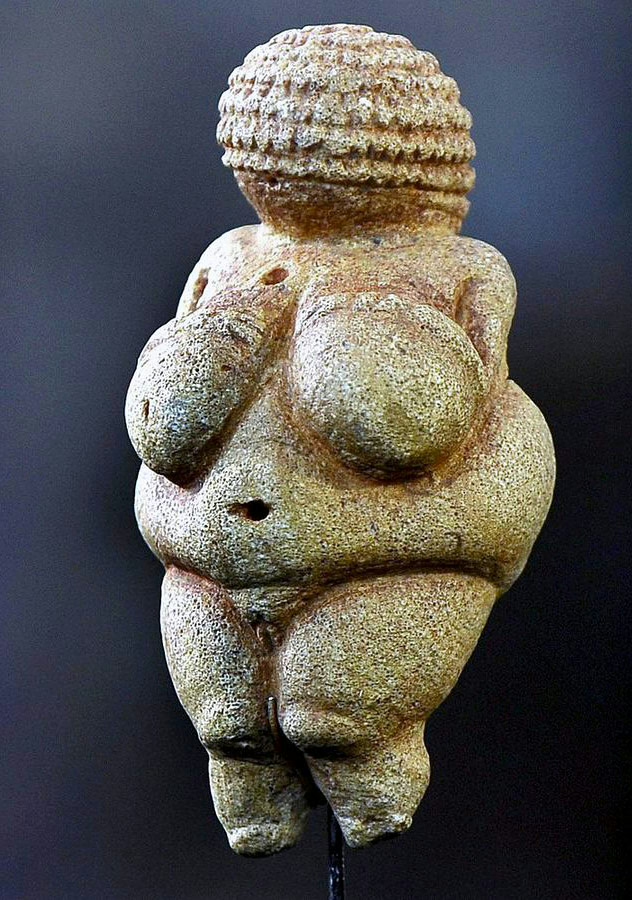As muse and source of inspiration, women have always occupied a central place in the history of sculpture. From the earliest depictions of prehistoric Venus to contemporary works, the female muse inspires artistic representations. This fascination with the female body spans centuries and styles, but is also subject to the cultural, religious and moral restrictions of different eras. Without doubt, this makes the representation of women as much an artistic issue as a political one.
Prehistoric Venuses: women as symbols of fertility and mystery
The first known sculptures depicting women date back to prehistoric times. With the famous Paleolithic Venuses, such as the Venus of Willendorf. Small figurines, often callypige (i.e. with generous, accentuated shapes, especially the hips and buttocks). symbols of fertility and protection. They embody abundance and the continuity of life. Their exaggerated forms are both a celebration of the female body and a testimony to the spiritual and cultural values of the time. In these sculptures, women are both deified and mystified. They are linked to nature and the cycle of life.
Women in Antiquity: between idealization and sensuality
In ancient civilizations, particularly Greece and Rome, the representation of the female body became more realistic, but still imbued with aesthetic idealization. Greek sculpture celebrated the beauty of the naked body, seeking to capture an ideal of physical and moral perfection. Works such as Praxiteles'Aphrodite of Cnidus, one of the first monumental representations of a nude woman, marked a turning point in the way femininity was portrayed. Far from modesty, Greek sculpture paid tribute to the sensuality of the female body, while placing it in a divine or heroic setting.
However, these idealized representations were not exempt from moral censure. In Rome, for example, female nudity was rarer and often veiled in symbolic meaning, reserved for mythological figures or allegories of Virtue. The female body, while an object of aesthetic desire, remained marked by strict cultural codes.
The Middle Ages and the Renaissance: women's bodies under religious control
With the advent of Christianity in the Middle Ages, the view of the female body changed radically. The woman became a subject of moral duality: she was either the Virgin Mary, pure symbol of purity and divine maternity, or the sinner, temptress and responsible for the fall of man, in the image of Eve. Sculptures from this period are often marked by religious censorship, and nudity is almost totally absent, except in very restricted allegorical or biblical contexts.
The advent of the Renaissance
However, the Renaissance gradually reintroduced nudity into art, influenced by the rediscovery of classical Greek and Roman ideals. The female body once again took center stage, thanks to artists such as Michelangelo and Botticelli. Botticelli's Venus, though modest by today's standards, reincarnates a subtle sensuality. Harmony with nature and divine beauty. Yet even then, female representations remained under the watchful eye of religious authorities. Every nude unveiled had to be justified by an allegory or mythological story to escape censorship.
Les Temps Modernes: rebellion against taboos
With the arrival of the Enlightenment and the political and social revolutions of the 18th and 19th centuries, women's sculpture explored more audacious territory. The female body gradually freed itself from religious guardianship to become an artistic subject in its own right. However, this emancipation remained tinged with provocation and scandal. For example,Édouard Manet'sOlympiacaused a monumental scandal in 1865. The reason for this was the direct, frontal depiction of a naked woman, aware of her body and her status.
In sculpture, artists like Rodin capture passion and eroticism in works such as Le Baiser. These works were sometimes considered too explicit for the mores of the time. Artists demonstrated a growing desire to represent the female body in all its complexity. Sensual, strong, vulnerable and autonomous, a new representation of woman.
Contemporary times: Women between liberation and censorship
Today, sculptors continue to draw inspiration from the female body. In a context where debates on gender, feminism and the representation of the body have radically evolved. With the sexual liberation of the 1960s and 1970s came greater artistic freedom. This period was also marked by new forms of censorship. Questions of objectification and sexualization of the female body were at the forefront. Artists were often faced with a dilemma. How to represent the female body without falling into the trap of being reduced to an object of male desire?
Artists such as Louise Bourgeois and Niki de Saint Phalle have reinterpreted the female body from a new perspective. Detaching it from the traditional masculine ideal to make it a symbol of strength, suffering or emancipation. Bourgeois, with sculptures such as Maman, presents women in all their complexity. Oscillating between protection and threat, gentleness and monstrosity.
Even today, however, censorship has not completely disappeared. Representations of female nudity are still subject to cultural and religious prohibitions. Censorship can also take more insidious forms. Censorship imposed by social networks or the criticism of certain social movements towards works deemed too provocative.
Our modern-day Venuses

Conclusion
In conclusion, the female body, from prehistoric Venus to the present day, has always fascinated, whether exalted, censured, sublimated or sexualized. It continues to fascinate sculptors, who see it as an inexhaustible source of inspiration. However, this fascination is inseparable from the norms and taboos of each era. The challenge for contemporary artists is to navigate between these multiple heritages, while finding new ways to explore and represent femininity without being trapped by stereotypes or fears of censorship.

